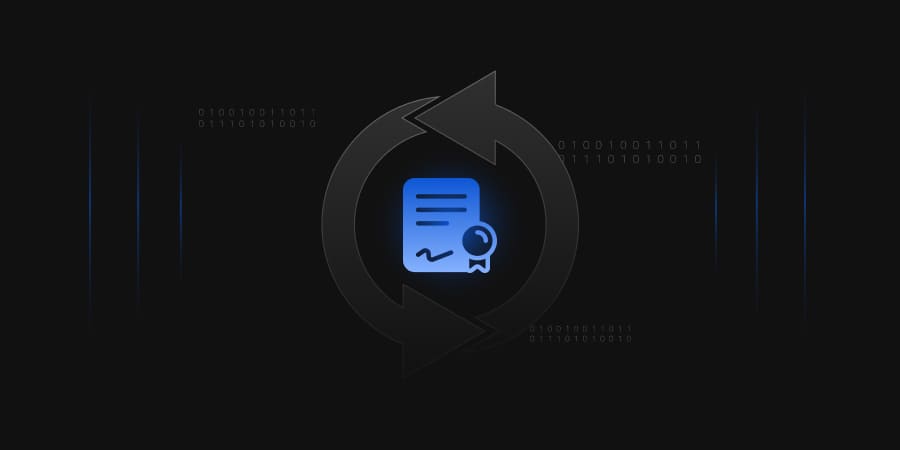Gone are the days of “set it and forget it” when it comes to TLS certificates. With the CA/Browser Forum’s approval of Ballot SC-081v3, the maximum lifespan of public TLS certificates is set to be reduced to 47 days by March 2029. While this may sound like just another industry update, it fundamentally transforms how organizations approach certificate management. This is not just a technical change. It’s a strategic shift in how we build, maintain, and secure machine identities in a high-stakes digital landscape.
Why Shorter TLS Certificate Lifespans are Preferred?
Until recently, TLS certificates were valid for up to 825 days. That was reduced to 398 days. Now, by March 2029, certificates will only last 47 days at most.
Now, let’s understand in detail the reason behind the preferred choice of a shorter certificate lifespan:
The Problem with Long-Lived Certificates
When a TLS certificate remains valid for over a year, it introduces significant security risks, such as:
- If a private key gets compromised: If the private key of the certificate is compromised, an attacker can impersonate the server or decrypt sensitive traffic for the entire duration of the certificate’s validity, potentially over a year, without triggering alarms.
- If a certificate authority (CA) mistakenly issues a certificate to the wrong entity due to a validation flaw, the window for exploitation remains open for an extended period.
- Forgotten certificates on old or decommissioned systems, also called orphaned certificates, can be exploited without anyone noticing.
- Over time, the older the certificate, the higher the chance it becomes outdated, misconfigured, or vulnerable to attack.
Shorter Lifespans Mean Shorter Risk Windows
By reducing certificate validity to 47 days, organizations achieve the following:
- Even if a certificate is compromised, it automatically expires soon, limiting the damage window.
- Organizations need to adopt cryptographic agility, the ability to react faster and rotate certificates regularly.
- This shift reduces reliance on outdated revocation systems, such as Certificate Revocation Lists (CRLs) and Online Certificate Status Protocol (OCSP), which were never designed to operate at the velocity or scale required for today’s dynamic cloud environments.
Industry-Wide Standardization and Trust
This isn’t just a recommendation. The CA/Browser Forum, which includes all major browser makers and Certificate Authorities, has unanimously approved this move.
- All browsers and platforms (Chrome, Safari, Firefox, etc.) are now on the same page.
- It brings consistency across the internet and reinforces trust in secure connections.
Bottom line is shorter certificate lifespans are becoming the new normal, not just for security, but for standardization.
Why Manual TLS Certificate Management Can’t Keep Up Anymore?
There was a time when renewing TLS certificates manually, using spreadsheets, calendar alerts, CA portals, or support tickets, was “good enough.” That worked when certificates lasted over a year.
But not anymore, with the shift toward 47-day certificate lifespans and domain validation reuse now limited to just 10 days, manual methods have gone from inefficient to outright dangerous.
When automation is missing, your certificate operations become highly vulnerable to the following risks:
- Unplanned Service Outages:
TLS certificate expirations are one of the leading causes of application outages. Gartner reports that 80% of organizations have experienced at least one certificate-related outage in the past two years. Most of these could have been prevented with automated renewal and monitoring. - Security Breaches: Misconfigured, forgotten, or rogue certificates leave gaps in your trust architecture. According to CyberArk’s 2025 report, over 50% of surveyed enterprises experienced security incidents related to expired or misused certificates, many of which could have been prevented with improved visibility and automation.
- Exponential Workload Increases:
The shift from 398-day to 47-day lifespans means your certificate renewal workload will increase by up to 10 times or 12 times. If you’re managing 10,000 certificates today, you’ll soon face over 120,000 renewal operations every year. Even the most experienced PKI teams can’t keep up with this scale manually. - Compliance Gaps and Audit Failures:
Manual processes lack centralized audit trails. When auditors come knocking, proving that every certificate is compliant, valid, and policy-bound becomes a nightmare, leading to failed audits, fines, and increased scrutiny.
If you’re managing certificates manually, you’re not just falling behind; you are inviting outages, security gaps, and compliance failures. Automation isn’t a luxury anymore. It is a necessity.
Capabilities That Scale in a 47-Day Certificate World
Adapting to 47-day TLS certificate lifespans is not just about faster renewals. It requires a mature, automated Certificate Lifecycle Management (CLM) strategy built on three core pillars:
Real-Time Discovery and Visibility
You can’t protect what you don’t know exists. In most organizations, certificates are scattered across various platforms, including cloud workloads, containers, third-party services, internal tools, and legacy infrastructure. These untracked or “hidden” certificates are one of the leading causes of unplanned outages and security incidents. A mature CLM solution must provide:
- Continuous, automated discovery of all certificates across environments
- Unified visibility across multiple certificate authorities and usage contexts
- Operational intelligence, like certificate ownership, location, expiration, and compliance status
End-to-End Automation
Manual processes cannot survive the shift from annual to monthly renewals. Without automation, even the most experienced teams will be overwhelmed by the sheer volume of renewal events, domain validations, and deployment cycles.
This isn’t just about speed; it’s about eliminating human error, enforcing consistency, and ensuring every certificate is correctly configured, properly deployed, and bound to its target service or device before expiration.
Advanced CLM platforms provide capabilities:
- One-click bulk renewals and revocations
- Automatic certificate binding to endpoints
- Workflow handoffs to reassign certificate ownership
- Support for multiple CAs to avoid vendor lock-in
- Support for ACME protocols, APIs, DevOps toolchains, and IT service management platforms
In short, automation does more than reduce workload. It enables a self-healing certificate environment that is resilient, automated, and secure by design.
Policy Enforcement and Crypto Agility
As certificate volume grows exponentially, strong governance is non-negotiable. A mature CLM solution must enforce policies for allowed CAs, key lengths, and algorithms, Extended key usage, etc. The policies must also restrict unauthorized issuance paths, apply role-based access controls to ensure proper ownership and accountability, and maintain a complete, real-time audit trail for every certificate action.
A certificate management platform should enforce these policies automatically by validating each request against pre-approved standards. It must also restrict the use of unauthorized certificate authorities to ensure trust and uniformity across the environment.
Looking forward, the ability to switch cryptographic algorithms quickly is just as important. The 2030 deadline of post-quantum cryptography will demand fast and seamless updates across certificate ecosystems. A capable CLM solution should support such transitions without disrupting services or exposing the organization to operational risk. This level of flexibility is now a core requirement for any enterprise looking to secure digital trust at scale.
CertSecure Manager is Built for the 47-Day Future
The shift to 47-day TLS certificate lifespans is not just a policy change; it is a transformation in how digital trust must be managed. It brings with it increased operational complexity, a higher risk surface, and a non-negotiable demand for automation and agility.
Meeting this challenge requires more than faster tools. It demands a platform that’s built from the ground up to think ahead, adapt in real time, and unify the entire certificate lifecycle into a single, scalable system.
This is where CertSecure Manager delivers.
Always-On Discovery and Contextual Visibility
Short-lived certificates leave no room for error. A missed renewal or an untracked certificate can bring down critical systems. CertSecure Manager solves this with continuous discovery. It actively scans across on-prem infrastructure, multi-cloud environments, hybrid environments, and edge devices and containers.
Every certificate is captured in a centralized inventory, with full context of who owns it, where the certificate is deployed, when the certificate expires, and whether the CA policies comply with your organization’s cryptographic standards and procedures.
This is not just visibility, it’s intelligence. And it’s the foundation for proactive risk mitigation.
True End-to-End Automation
What breaks in a 47-day world isn’t just visibility; it is the volume of repetitive actions, such as request approvals, CSRs, domain validations, renewals, and deployments.
CertSecure Manager automates the entire lifecycle, from request and validation to issuance, deployment, and binding.
No manual file transfers. No last-minute surprises. Just zero-touch, policy-bound execution across your infrastructure. It includes:
- Renewal agents that preemptively rotate and deploy certificates ahead of expiry
- Bulk operations for mass renewal, revocation, or migration during compliance or CA events
- Certificate binding at scale, ensuring services stay online without human involvement
Designed to Adapt Crypto Agility
The crypto landscape is evolving. With quantum computing on the horizon and trust anchors shifting fast, agility is now a core requirement. CertSecure Manager is built for this future:
- Supports post-quantum algorithms and crypto transitions
- Enables fast re-keying and policy changes across environments
- Handles sudden CA distrust events without disruption
Whether you’re facing regulatory changes, migrating PKI vendors, or preparing for a quantum-safe world, CertSecure Manager gives you the control and flexibility to adapt instantly.
Shorter certificate lifespans demand smarter infrastructure. CertSecure Manager transforms certificate management from a manual, error-prone process into a resilient, intelligent, and automated system, ready for today’s complexity and tomorrow’s challenges.
Automated TLS Certificate Lifecycle Workflow
| Step | Function | CertSecure’s Automation Workflows |
|---|---|---|
| Discovery | Continuously scan and inventory all certificates (internal and public) across endpoints, infrastructures, and networks. | Run scheduled or real-time discovery agents; pull data from CT logs, CA inventory, certificate stores, and the network. |
| Monitoring | Track expiration, ownership, and policy status. | Set reports and expiry-based alerts (e.g., 90, 30, or 7 days before expiry) sent via email, ITSM(Service Now), or SIEM. |
| Renewal Initiation | Auto-initiate renewal process based on expiration threshold or renewal schedule. | Generate a CSR, validate the domain (ACME or API), and submit it to the CA. |
| Certificate Issuance | Issue new certificate from CA (internal/public). | Automatically fetch renewed certificates upon CA approval. |
| Deployment & Binding | Deploy renewed certificate to the correct service/application/load balancer. | Automate push and binding certificates to endpoints like webservers, databases, and load balancers. |
| Logging & Audit | Maintain logs for every action, approval, and change. | Generate audit-ready logs with timestamps, user actions, and change history. |
| Policy Enforcement | Enforce certificate standards (including key length, Certificate Authority, lifespan, and Subject Alternative Names). | Use templates to restrict misissuance or use of weak crypto. |
Conclusion
The transition to 47-day TLS certificates is not just a technical adjustment. It is a complete shift in how organizations must manage digital trust across their infrastructure. With certificates expiring every few weeks and validations happening more frequently, the risks associated with manual tracking, delayed renewals, and misconfigurations are becoming too great to ignore.
Handling this shift effectively requires more than short-term fixes. It demands a long-term strategy built on automation, visibility, and policy enforcement. CertSecure Manager is designed to meet this challenge by ensuring that every certificate is discovered, renewed, deployed, and governed in a fully automated and secure manner.
By adopting CertSecure Manager as part of your certificate lifecycle strategy, you not only reduce operational overhead and avoid outages but also enhance security and compliance. You are building a resilient foundation that will support your organization as it navigates evolving cryptographic standards, compliance requirements, and future security threats. The move to 47-day certificates is already underway. The right time to modernize your approach is now.




